
According to the Joint Committee on Taxation, will raise billions of dollars in taxes on Americans making less than $400,000 annually.” The United States Senate voted 51-50 to pass the bill on August 7, 2022, and the United States House of Representatives voted 220-207 to pass the bill on August 12, 2022. The roughly $700 billion legislation cleared Congress without a single Republican vote.
In 2023, taxes will increase by $16.7 billion on American taxpayers earning less than $200,000—a nearly $17 billion tax targeted solidly at low-and middle-income earners next year, amidst stagflation.
The $17 billion hit alone is confirmation that the Biden pledge to not raise taxes on anyone earning less than $400,000 is shattered by the latest tax-and-spend bill.
The proposal would raise another $14.1 billion from taxpayers earning between $200,000 and $500,000.
According to JCT data, 98 percent of all tax returns filed by those in the $200,000 to $500,000 category are filed by those earning between $200,000 and $400,000, with at least three-fourths of the income in the $200,000 to $500,000 category also coming from those below $400,000, meaning it is likely that at least half of all new tax revenue raised next year would come from those earning under $400,000.
Throughout the ten-year window, the average tax rate for nearly every single income category would increase.
By 2031, when the new green energy credits and subsidies provide an even greater benefit to those at higher incomes, those earning below $400,000 are projected to bear as much as two-thirds of the burden of the additional tax revenue collected that year.
“The more this bill is analyzed by impartial experts, the more we can see Democrats are trying to sell the American people a bill of goods,” Crapo continued. “Non-partisan analysts are confirming this bill raises taxes on the middle class and produces no meaningful deficit reduction when gimmicks are removed and the full cost is accounted for. It’s no wonder this bill, which was drafted behind closed doors, is being rushed through the Senate at record pace.”
In 2023, taxes will increase by $16.7 billion on American taxpayers earning less than $200,000—a nearly $17 billion tax targeted solidly at low- and middle-income earners next year, amidst stagflation.
Read More























Recent Comments